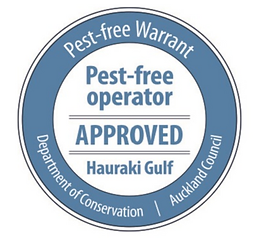




Passenger Information for trips to
Hauraki Gulf Pest-Free Islands
Seasprite II is licensed by the Department of Conservation (DOC) and the Auckland Council to visit islands in the Hauraki Gulf. Our vessel has undergone strict inspections so we are licensed to visit conservation islands and hold a 'Pest-Free Warrant' that recognises our commitment to bio-security standards.
Fortunately, none of the pest-free islands in the Hauraki Gulf are within swimming distance of rodents. However, pests can and do make it to our pest-free islands. The most likely way these destructive pests get there is by stowing away on (or in) your shoes or gear, on your kayak or in freight goods, building materials, vehicles and plants. Pests such as rats, mice, Argentine ants and plague skinks injure and kill our native wildlife and compete for their food. Invasive weeds can alter the habitat that wildlife needs to survive. Soil may contain plant diseases like kauri dieback, which is killing our kauri forests.

What you need to do to prepare for your trip to a pest-free island
PRINT and COMPLETE the relevant Bio-Security Checklist. BRING your completed Bio-Security Checklist with you to the vessel.
CHECK your gear for pests:
Check that your gear is free of rats, mice, ants, skinks, soil and seeds - especially camping gear which has ideal places for pests to hide when stored. Take extra care to ensure gear is pest-free if you have Argentine ants or rainbow skinks where you live.
CLEAN your gear and footwear:
Clean your clothing, footwear and camping gear to ensure they are clean and free of soil and seeds before and after each trip. Look out for the cleaning stations at the departure pier, and use the brush to scrub your shoes before boarding the vessel.
SEAL your gear properly:
Your food must be packed in rodent-proof/sealed containers (eg. hard plastic) to avoid attracting rodents. No open bags or boxes - everything you take on shore must be sealed or zipped close. Mice, ants and rainbow skinks can crawl in through the smallest hole. Be vigilant.
Pest-proof containers/bags include:
* Strong bags with the tops securely tied.
* Plastic barrels with large diameter screw-top lids.
* Day packs or overnight bags must be able to be completely closed/sealed and have no holes.
* Sleeping bags should be inside packs/bags. If loose, any holes created by drawstring closures of 'stuff bags' should be taped closed.
* Solid taped up cardboard boxes with no holes (not acceptable for Little Barrier Island). Note that these are not waterproof and not recommended.
If you have any doubts or questions about your packed items, please ask the crew.
IMPORTANT: You must take all rubbish with you when you leave any Hauraki Gulf Island.
Priority stowaway pests to check for:

Native to Australia, plague skinks were first recorded in Auckland during the 1960s and are now posting a threat to our rare native lizards. These Australian imports are prolific breeders and displace our native skinks. Their young are as small as matchsticks. Difficult to distinguish from our native copper skink except rainbow/plague skinks lay clusters of small white eggs. They are found in vegetation, stacked timber, garden supplies, potted plants etc. They thrive in gardens and garden centres, urban industrial and commercial sites. They love to bask in the sun.
Soil and weed seeds are easily transported on clothing and footwear or in your gear. Weeds can quickly take over, they can strangle our native bush. Soil can carry diseases that threaten native plants such as kauri dieback disease.
The rats in New Zealand are introduced pests, and threaten the long-term survival of native species. These pests eat native chicks, eggs, insects and lizards. They complete with our native species for food.
One of the world's top 10 invasive species, Argentine ants post a serious threat to New Zealand's biodiversity. They compete for food with native species and displace and eat native wildlife. They build to large numbers and are organised and aggressive. Found in both urban and industrial/commercial areas, inside and outside. They like warm, dry places and nest almost anywhere, especially in potted plants, soil, bark and building materials.
Other pests and threats to our pest-free islands:
Kauri dieback - Kauri dieback disease can kill kauri of all ages.
Ferrets - Although rabbits are the main diet of ferrets, they will attack, kill and eat native species.
Stoats - Stoats are 'public enemy number one' for New Zealand birds.
Weasels - Weasels are found in low numbers in most habitats in New Zealand. They pose a significant threat to native wildlife.
For more information go to the Department of Conservation Bio Security Page.
Found a Pest?
On the mainland: Get rid of the pest and clean your gear again.
On the vessel: Tell the crew what you have found and where it is.
On the island: Report sightings to the DOC Conservation Emergency Hotline 0800 DOC HOT (0800 362468)
